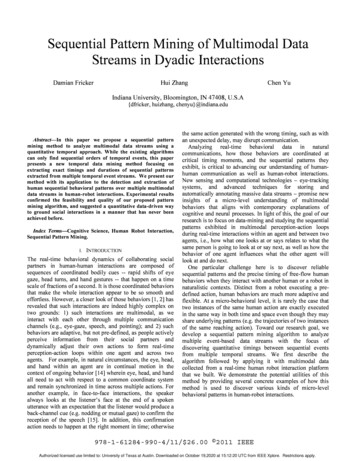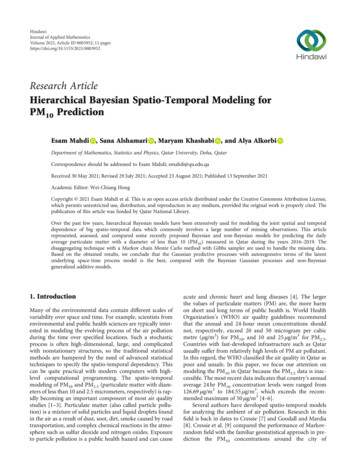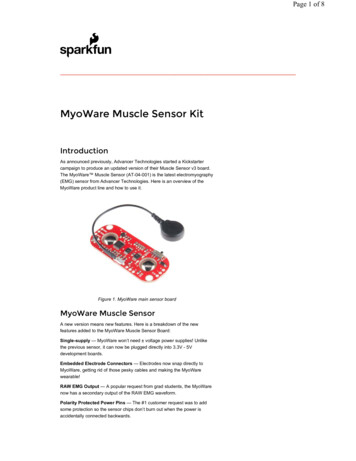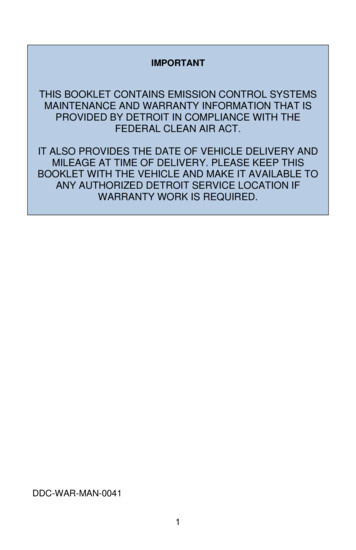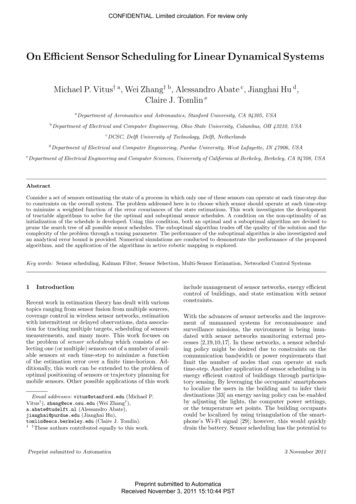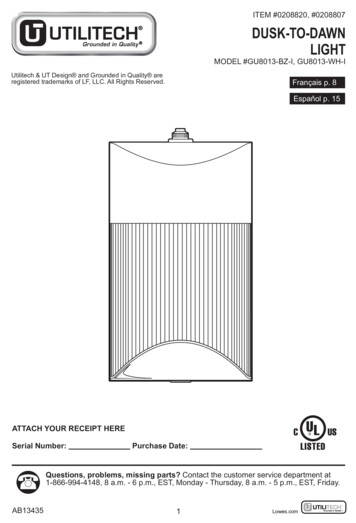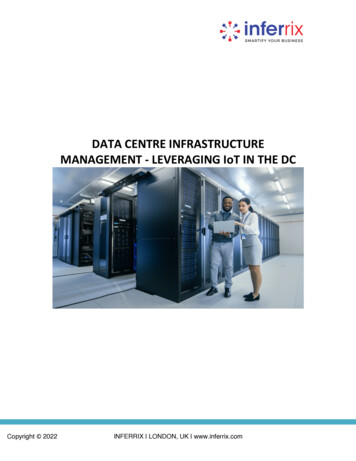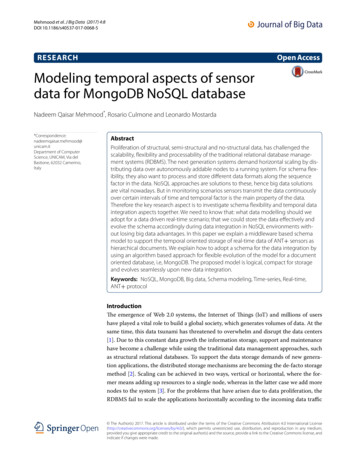
Transcription
Mehmood et al. J Big Data (2017) 4:8DOI 10.1186/s40537-017-0068-5Open AccessRESEARCHModeling temporal aspects of sensordata for MongoDB NoSQL databaseNadeem Qaisar Mehmood*, Rosario Culmone and Leonardo m.itDepartment of ComputerScience, UNICAM, Via delBastione, 62032 Camerino,ItalyAbstractProliferation of structural, semi-structural and no-structural data, has challenged thescalability, flexibility and processability of the traditional relational database management systems (RDBMS). The next generation systems demand horizontal scaling by distributing data over autonomously addable nodes to a running system. For schema flexibility, they also want to process and store different data formats along the sequencefactor in the data. NoSQL approaches are solutions to these, hence big data solutionsare vital nowadays. But in monitoring scenarios sensors transmit the data continuouslyover certain intervals of time and temporal factor is the main property of the data.Therefore the key research aspect is to investigate schema flexibility and temporal dataintegration aspects together. We need to know that: what data modelling should weadopt for a data driven real-time scenario; that we could store the data effectively andevolve the schema accordingly during data integration in NoSQL environments without losing big data advantages. In this paper we explain a middleware based schemamodel to support the temporal oriented storage of real-time data of ANT sensors ashierarchical documents. We explain how to adopt a schema for the data integration byusing an algorithm based approach for flexible evolution of the model for a documentoriented database, i.e, MongoDB. The proposed model is logical, compact for storageand evolves seamlessly upon new data integration.Keywords: NoSQL, MongoDB, Big data, Schema modeling, Time-series, Real-time,ANT protocolIntroductionThe emergence of Web 2.0 systems, the Internet of Things (IoT) and millions of usershave played a vital role to build a global society, which generates volumes of data. At thesame time, this data tsunami has threatened to overwhelm and disrupt the data centers[1]. Due to this constant data growth the information storage, support and maintenancehave become a challenge while using the traditional data management approaches, suchas structural relational databases. To support the data storage demands of new generation applications, the distributed storage mechanisms are becoming the de-facto storagemethod [2]. Scaling can be achieved in two ways, vertical or horizontal, where the former means adding up resources to a single node, whereas in the latter case we add morenodes to the system [3]. For the problems that have arisen due to data proliferation, theRDBMS fail to scale the applications horizontally according to the incoming data traffic The Author(s) 2017. This article is distributed under the terms of the Creative Commons Attribution 4.0 International /), which permits unrestricted use, distribution, and reproduction in any medium,provided you give appropriate credit to the original author(s) and the source, provide a link to the Creative Commons license, andindicate if changes were made.
Mehmood et al. J Big Data (2017) 4:8[2]; because they require data replication on multiple nodes, so they are not flexible toallow data and read/write operations distributed over many servers. So we need to findsystems that would be able to manage big volumes of data.This flood of data passes challenges not only due to its sheer size but also due to thedata types, hence demands more robust mechanisms to tackle different data formats.The Web, e-science solutions, sensor laboratories and industrial sector produce in abundance both structural, semi-structural and non-structural data [4–6]. This is not a newproblem, and can be traced back to the history of object-relational databases, under thename of Object-Relational Impedance Mismatch [7]. This mismatch is natural, when wetry to model an object into a fixed relational structure. Similarly, the digital informationwith different structures, such as natural text, PDF, HTML and embedded systems data,is not simple enough to capture as entities and relationships [8]. Even if we manage todo this, it will not be easy to change afterwards, hence such mechanisms are rigid forschema alteration because they demand pre-schema definition techniques. Several newgeneration systems do not like to fix their data structure to a single schema; rather theywant their schema to evolve in parallel to an entity data type’s adaptation, hence theywant flexibility [9, 10].Besides the data abundance and different formats, the rapid flow of data has alsoattracted the researchers to find mechanisms to manage the data in motion. Typicallythis is to consider that, how quickly the data is produced and stored, and its associatedrates of retrieval and processing. This idea of data in motion is evoking far more interestthan the conventional definitions, and needs a new way of thinking to solve the problem [11]. This is not associated only with the growth rate at the data acquisition end,but also data-flow rate during transmission; as well the speed at which data is processedand stored in the data repositories. Any way, we are aware of the fact that today’s enterprises have to deal with petabytes instead of terabytes; and the increase in smart objecttechnology alongside the streaming information has led the constant flow of data at apace that has threatened the traditional data management systems [11]. RDBMS usetwo-dimensional tables to represent data and use multi-join transactional queries for thedatabase consistency. Although they are mature and still useful for many applications,but processing of volumes of data using multi-joins is prone to performance issues [12,13]. This problem is evident when extensive data processing is required to find hiddenuseful information in huge data volumes; but such data mining techniques are not inour current focus [14–17], as we limit our discussion to NoSQL temporal modeling andschema based data integration.Above discussed problems of prolific, multi-structured heterogeneous data in flowurge the researchers to conduct research to find alternate data management mechanisms, hence NoSQL data management systems have appeared and are now becominga standard to cope with big data problems [11, 18]. Such new data management systems are being used by many companies, such as Google, Amazon etc. The four primarycategories of their data model are: (i) key-value stores, (ii) column-oriented, (iii) document, and (iv) graph databases [19, 20]. For rationality, sanity and demonstrating thestorage structure, the researchers follow the database schema techniques without losingthe advantages of schema flexibility provided by NoSQL databases. Such schema modeling strategies in NoSQL databases are quite different from the relational databases.Page 2 of 35
Mehmood et al. J Big Data (2017) 4:8Collections, normalization and document embedding are few variants to consider during building schema models because they affect the performance and storage effectivelybecause such databases grow very quickly.While dealing with real-time data, in continuous or sliced snapshot data streams,the data items possess observations which are ordered over time [21]. During previousyears, research efforts had been conducted to capture temporal aspects in the form ofdata models and query languages [22, 23]. But mostly those efforts were for relational orobject-oriented models [23], and can be considered as a conceptual background to solveadvanced data management challenges [24]. The emerging applications, such as sensordata [25], Internet traffic [26], financial tickers [27, 28] and e-commerce [29], producelarge volumes of timestamped data continuously in real-time [30, 31]. The current methods of centralized or distributed storage with static data impose constraints in addressing the real-time requirements [32], as they inflict pre-defined time convictions unlesstimestamped attributes are explicitly added [31]. They have limited features to supportthe latest data stream challenges and demand research to augment the existing technologies [31, 33].In remote healthcare long term monitoring operations, based on Body Area Networks(BAN), demand low energy consumption due to limited memory, processing and battery resources [34]. These systems also demand communication and data interoperability among sensor devices [35]. Recently a propriety protocol ANT provides these lowenergy consumption features; and strengthens the goals of IoT through the interoperability of devices based on Machine-to-Machine (M2M) mechanisms, which employs usecase specific device profile standards [34, 36]. Device interoperability, low energy andminiaturisation features allow the building of large ecosystems, hence enable millions ofvendor devices to get integrated and interoperated. IoT ecosystems want general storagemechanisms having structural flexibility to accept different data formats arriving frommillions of sensory objects [37]. The non-relational or NoSQL databases are schema-free[2]; and allow storage of different data formats without prior structural declarations [34,37]. However for the storage we need to investigate the NoSQL models to design anddevelop [8, 22]; besides flexibly preserving the big data timestamped characteristics forthe massive real-time data flow during acquisition processes [24]. Although all NoSQLdatabases have unique advantages, but document-oriented storage, as MongoDB provides, is considered robust for handling multiple structural information to support IoTgoals [38]. This rejects the relational structural storage and favours Java Script ObjectNotations (JSON) documents to support dynamic schemas; hence provide integration todifferent data types besides scalability features [39, 40].This article presents a general approach to model temporal aspects of ANT sensordata. The authors develop a prototype for the MongoDB NoSQL real-time platform anddiscuss the temporal data modeling challenges and decisions. An algorithm is presentedwhich integrates JSON data as hierarchical documents and evolves the proposed schemawithout loosing flexibility and scalability.This article is organized as follows. "Data stream and data stream management systems(DSMS)" is about time series data. Different NoSQL databases are discussed in detail in"Limitations of RDBMS". It is followed by a subsection discussing MongoDB as a wellknown document oriented database. "Big data management frameworks", discusses thePage 3 of 35
Mehmood et al. J Big Data (2017) 4:8different techniques to model time series data using MongoDB. This follows a middleware description explaining how to store data in the MongoDB. "Modeling aspects" and"Temporal modeling for an ANT sensor use case" give future work and a short summary respectively.Time series in medical dataA time series is a sequence of numerical measurements from observations collected atregular durations of time. Such successive times can either be continuous or discretetime periods. These sequence of values at particular intervals are common in situations,such as weekly interest rates, stock prices, monthly price indices, yearly sales figures,weather reports, patient’s medical reports and so forth.Healthcare monitoring systems measure physiological and biological body parameters,using BAN, of a patient’s body in real-time. Because timely information is an importantfactor to detect immediate situations and to improve decision making processes, basedon a patient’s medical history, so considering temporal aspects are vital. Such sequenceof values represent the history of an operational context and is helpful in a number ofuse cases where history or order is required during the analysis. This sequences of dataflows in streams of different speeds and also needs proper management.Data stream and data stream management systems (DSMS)Data streams, as continuous and ordered flow of incoming data records, are common inwired or wireless sensor network based monitoring applications [31]. Such widely useddata intensive applications don’t directly target their data models for persistence storage, because the continuously arriving multiple, rapid, time-varying, and unboundedstreams lose the support for storage as an entirety [31], and a portion of arrived stream isrequired to keep in the memory for initial processing. This is not feasible using the traditional DBMS to load the entire data and operate upon it [41]. Golab et al. [31] highlightsthe following requirements for the DSMS. Data models and queries must support order and time based operations.Summarized information is stored, owing to the inability of entire stream storage.Performance and storage constraints do not allow backtracking over a stream.Real-time monitoring applications must react to outlier data values.Shared execution of many continuous queries is needed to ensure scalability.DBMS comparison with DSMSThere are three main differences while comparing DSMS with the DBMS. First theydo not directly store the data persistently rather keep the data in the main memory forsome time for autonomous predictions to respond to outlier values, such as fire alarm,emergency situations as in healthcare domain etc [42]. Therefore DSMS computation isgenerally data driven, i.e. to compute the results as the data is available. In such cases thecomputation logic always resides in the main memory in the form of rules or queries.On the other hand DBMS approach is query driven, i.e. to compute the results usingqueries over permanently stored data. Because of data driven nature, the very first issuewhich DSMS must solve is to manage the changes in data arrival rate during a specificPage 4 of 35
Mehmood et al. J Big Data (2017) 4:8query lifetime. Second, it is not possible to keep all the previous streams in the memorydue to their unbounded and massive nature. Therefore only a summary or synopsis iskept in the memory to answer the queries whereas the rest of the data is discarded [21].Third, since we cannot control the order of the data arrival, critical to consider the orderof the arrived data values, hence their temporal attribute is essential. In order to handlethe unboundedness of the data, the fundamental mechanism used is that of window which is used to define slices upon the continuous data to allow correct data flow infinite time [42].Data-driven computation, unbounded streams and timestamped data are the mainissues that have arisen while dealing with streaming data, such as during sensor dataacquisition in monitoring scenarios. This poses novel research challenges and excitingdirections to follow with focus on temporal model, techniques and algorithms. Theseissues need proper management for any of the relational, object-relational or big datamanagement research paradigms; and aim at data modeling and successfully exploiting the time-dependent characteristics for these paradigms ranging from the temporalbased models to query models. Although the directions, developed in previous years forthe relational or object-relational domains, provide the basic fundamental footsteps tofollow; but require further insights to tackle the advanced Big Data challenges [31, 41].In particular the emerging real-time data-driven applications, having volumes of various data velocities, demand such research inputs to bring number to advantages to theInformation and Communication Technology (ICT) world, specially in promoting IoTand Web 2.0 and 3.0. Hence it is becoming mandatory to tackle the challenges associatedwith temporal data streams for which the relational database management systems havegiven in.Limitations of RDBMSThis section explains what traditional relational approaches lack, why they are not bestfit for managing time-variant, dynamically large and flowing data. This absence hasopened the door for a disruptive technology to enter into the market and to gain widespread adoption in the form of NoSQL databases, as it offers better, efficient, cheaper,flexible and scalable solutions [43]. Features lacking in RDBMS are: Flexibility RDBMS restrict the applications to a predefined schema; so any changein the application requirements will lead to the redefinition of the database schema[8, 9]. Using RDBMS the developers have to rely on the data architects or modelers,as they miss developer centric approach from application inception to the completion [10]. Even in the case of the schema evolution especially in dynamic applicationsscenarios [9], as this is observed in information changing scenarios during dynamicevents generation in new generation systems [11]. NoSQL systems have a strongcoupling between data models and application queries, so any change in the querywill require changes to the model, which is flexible [10]. In contrast to this RDBMSsystems have logical and physical data independencies, where database transactionqueries come into play only when the data model is defined physically [10]. Scalability Over more than half a century RDBMS have been used by differentorganizations as they were satisfying the need of business dealing with static, queryPage 5 of 35
Mehmood et al. J Big Data (2017) 4:8intensive data sets since these were comparatively small in nature [44]. For the largedata sets the organizations had to purchase new systems as add-on to the system, asthe single server host the entire database. For scaling we need to buy a large moreexpensive server [43]. For the big data applications RDBMS systems are forced to usedistributed storage, which includes table partitioning, data redundancy and replication; because of disk size limits and to avoid hard disk failures [10]. Such data distribution involve multiple table joins, transaction operations running upon multipledistributed nodes, disk lock management and ACID (atomicity, consistency, isolation, and durability) compliance hence affect the performance adversely. The notionof vertical scalability allows the addition of more CPUs, memory and other resources[8]; but quickly reaches its saturation point [10]. Data structures RDBMS were in the era when the data was fairly structured, but nowdue to the advent of new generation trends, such as IoT, Web 2.0 etc. the data is nowno more statically structural [43], which involves unstructured data (e.g., texts, socialmedia posts, video, email). Therefore RDBMS database transactions and queriescome to play their role in already designed data models; in contrast to the NoSQLdatabases, which support application specific queries and allow dynamic data modeling [10]. Source codes and versioning Relational databases are typically closed source withlicensing fees. Off-the-shelf RDBMS do not provide support for data versioning, incontrast to the NoSQL databases which support natively [10]. A list of open andclosed source NoSQL databases is present in [45]. Sparsity RDBMS databases when deal with large data sets, upon missing values thereis possibility of a lot of sparsity in the data sets.Data proliferation, schema flexibility and efficient processing are the problems appearingduring the development of latest data-driven applications, as we learned in "Introduction". We learned that RDBMS are not sufficient to deal these issues, and don’t meetthe latest requirements of the next generation real-time applications [24, 31, 33]. Volume, Variety and Velocity are the three corresponding big data characteristics [10, 18,46], which are discussed in "Big data management frameworks", which is about a precisediscussion regarding big data frameworks.Big data management frameworksA big data management framework means the organization of the information according to the principles and practices that would yield high schema flexibility, scalabilityand processing of the huge volumes of data, but for which traditional RDBMSs are notwell suited and becomes impractical. Therefore, there is a need to devise new data models and technologies that can handle such big data. Recent research efforts have shownthat big data management frameworks can be classified into three layers that consist offile systems, database technology, and programming models [19]. However in this articlewe shall focus upon database technologies only in context of the healthcare domain withreal-time and temporal perspective.NoSQL also be interpreted as the abbreviation of “NOT ONLY SQL” or “no SQL at all”[45], whereas this was first used by Carlo Strozzi in 1998 for his RDBMS that did not offerPage 6 of 35
Mehmood et al. J Big Data (2017) 4:8an SQL interface [47]. NoSQL databases are often used for storing of the big data in nonrelational and distributed manner, and its concurrency model is weaker than the ACIDtransactions in relational SQL-like database systems [14]. This is because NoSQL systemsare ACID non-compliant by design and the complexity involves in enforcing ACID properties does not exist for most of them [10]. For example some of the ACID compliantNOSQL databases are: Redis [48], Aerospike [49] and Voldemort [50] as key-value stores[51]; where as Neo4jDB [52] and Sparksee are as graph-based data stores [8, 51]. In contrast to this MongoDB is not ACID compliant document-oriented database [8].The V’s of big dataThe V’s of big data is paramountly, even in healthcare, refer to as mainly for Volume,Variety, Velocity and Veracity [14]. The first three V have been introduced in [53], andthe V for Veracity has been introduced by Dwaine Snow in his blog Thoughts on Databases and Data Management [54].Volume Prolific data at scale creates issues ranging from storage to its processing.Velocity Real-time data, data streams—analysis of streaming data, data snapshots inthe memory for quick responses, availability for access and delivery.Variety Many formats of data—structured, unstructured, semi-structured, media.Veracity Deals with uncertain or imprecise data, its cleaning before the processing.Variety and Velocity goes against it as both do not let to clean the data.NoSQL database categoriesBased on the differences in the respective data models, NoSQL databases can be organized into following basic categories as: key-value stores, document databases, columnoriented databases and graph databases [10, 14, 19, 20].Key‑value storesThese are systems that store values against the index keys, as key-value pairs. The keysare unique to identify and request the data values from the collections. Such databaseshas emerged recently and are influenced heavily by Amazon’s Dynamo key-value storedatabase, where data is distributed and replicated across multiple servers [62]. The values in such databases are schema flexible and can be simple text strings or more complexstructures like arrays. The simplicity of its data model makes the retrieval of informationvery fast, therefore supports the big data real-time processing along the scalability, reliability and highly available characteristics. Some of the key-value databases store dataordered on the keys, such as Memcached [55] or Berkeley DB [66]; while others do not,such as Voldemort [50] etc. Whereas some keep entire data in memory, such as Aerospike [49], Redis [48]; others use it after writing it to the disk permanently (like Aerospike, MemcacheDB [56] etc.) with the trade-off replying to the queries in real-time. Thescalability, durability and flexibility depends upon different mechanisms like partitioning, replication, object versioning, schema evolution [19]. Sharding, also known as partitioning, is the splitting of the data based upon the keys; whereas the replication, alsoknown as mirroring, is the copying of the data to the different nodes.Amazon’s Dynamo and Voldemort [50], which are used by Linkedin, apply this datamodel successfully. Other databases that use this model of data category are such as:Page 7 of 35
Mehmood et al. J Big Data (2017) 4:8Redis [48], Tokyo Cabinet [67] and Tokyo Tyrant [68], Memcached [55] and MemcacheDB [56], Basho Riak [60], Berkeley DB [66] and Scalaris [69]. Whereas Cassandrais a hybrid of key-value and column-oriented database models [57]. Table 1 summarizesthe characteristics of some of the Key-value stores.Column‑oriented databasesRelational databases have their focus on rows in which they store the instances or therecords and return rows or instances of an entity against a data retrieval query. Suchrows posses unique keys against each instance for locating the information. Whereascolumn-oriented databases store their data as columns instead of the rows and use indexbased unique keys over the columns for the data retrieval. This supports attribute levelaccess rather than the tuple-level access pattern.Only query relevant necessary columns are required to be loaded, so this reduce theI/O cost significantly [70]. These are good for read-intensive applications, as they onlyallow relevant data reads because each column contains contiguous similar values; socalculating aggregate values will also be very fast. More columns are easily addable and acolumn may be further restructured called super-column, where it contains nested (sub)columns (e.g., in Cassandra) [14]. Super columns are key-value pairs, where the valuesare columns. Columns and super-columns are both tuples with a name and value. Thekey difference is that a standard column’s value is a string, whereas a super-column’svalue is a map of columns. Super-columns are sorted associative array of columns [71].Google’s Bigtable, which played the inspirational role for the column databases [74], isa compressed, high performance, scalable, sparse, distributed multi-dimensional databasebuilt over a number of technologies, such as Google File System (GFS) [75], a cluster management system, SSTable file format and Chubby [76]. This provides indexes over rows, columns, as well as a third timestamp dimension. Bigtable is designed to scale across thousandsof system nodes and allows to add more nodes easily through automatic configuration.This was the first most popular column oriented database of its type however lattermany companies introduced some other variants of it. For example Facebook’s Cassandra [77] integrates the distributed system technologies of Dynamo and the data modelfrom Bigtable. It distributes multi-dimensional structures across different nodes basedupon four dimensions: rows, column families, columns, and super columns. Cassandra was open sourced in 2008, and then HBase [72] and Hypertable [78], based upon aproprietary Bigtable technology, have emerged to implement similar open source datamodels. Table 2 provides the description about some column-oriented databases in acategorical format.Graph databasesGraph databases, as a category of NoSQL technologies, represent data as a network ofnodes connected with edges and are having properties of key-value pairs. Working onrelationships, detecting patterns and finding paths are the best applications to be solvedby representing them as graphs. Neo4j [52], Allegro Graph [79], ArangoDB [80] and OrientDB [81] are few examples of such systems, and are described along their characteristics in a categorical format in Table 3. Neo4j is the most popular open source, embedded,fully transactional with ACID characteristics graph-based database. This is schemaPage 8 of 35
Het of (key, value); complex types(string, binary, list, set, sorted set,hashes, arrays); key can be anybinary e.g. JPEGData types (flags, counter, sets, registers, maps, hyperlog)Complex key-value compoundobjects (e.g. lists/maps); supportedqueries: get, put and delete; nocomplex query filters; simple api forpersistence [64]; schema-evolutionDynamo [62] based to support bothReplication, partitioning, highly availdocument and key-value modelsable, versioning[65]; secondary indexes; DynamoDBTitan: integratable graph databaseRedis from S. Sanfilippo [48]Riak [60] from Basho TechnologiesVoldemort from LinkedIn [50]DynamoDB from Amazon [65]Twitter, GitHub, Flickr, StackOverflowCERN, Comcast, eBay, Netflix, GitHubAppNexus, Kayak, blueKai, Yashi,ChangoLiveJournal, Wikipedia, Flickr, Bebo,CraigslistWho uses itAuto data partitioning and replication, versioningPopular, two of the four ACID properties: consistency and durability;elastic MapReduce for Hadoop;AWS SDK to store JSONIn-memory with disk persistence, bigfault-tolerant hash table; no ACID,pluggable serialization (e.g. avro,java) and storage engine (concurrentHashMap, mysql, BDB JE)Amazon, BMW, duolingo, lyft, redfin,adrollLinkedIn, GiltSharding, replication, master-less [61], High available; Dynamo base [62]; in- AT and T, Comcast GitHub, UKHealth,backup and recoverymemory with disk persistence; relaxweather channelconsistency; MapReduce, REST-full;enterprise and cloud versions; RiakKV base Riak TimeSeries [63]Auto partitioning, replication, persistent levelsMost popular in-memory with diskpersistence; ACID; MapReducethrough Jedis [58], r 3 [59]In-memory database with disk persistence; highly scalableAuto partition, synch. and asynch.replicationHybrid of key-value and columnoriented models; Cassandra querylanguage: SQL like modelIn-memory cache systems, no diskpersistence (MemcacheDB givepersistent storage [56]); file systemstorage, ACIDCassandra from facebook [57]Auto sharding, no replication andpersistencyDescriptionIn-memory very fast database withdisk persistence. ACID with relaxoptionsSet of key-value in associative arrayMemcached from http://www.bradfitz.com [55]ScalabilityAerospike from http://www.aerospike. Associate keys with records (i.e rows); Auto partition, synch. replicationcom [49]namespaces (for dataset) divide intosets (i.e tables); key index recordsData modelNameTable 1 Key-value storesMehmood et al. J Big Data (2017) 4:8Page 9 of 35
Tab
Therefore the key research aspect is to investigate schema flexibility and temporal data integration aspects together. We need to know that: what data modelling should we adopt for a data driven real-time scenario; that we could store the data effectively and evolve the schema accordingly during data integration in NoSQL environments with-


